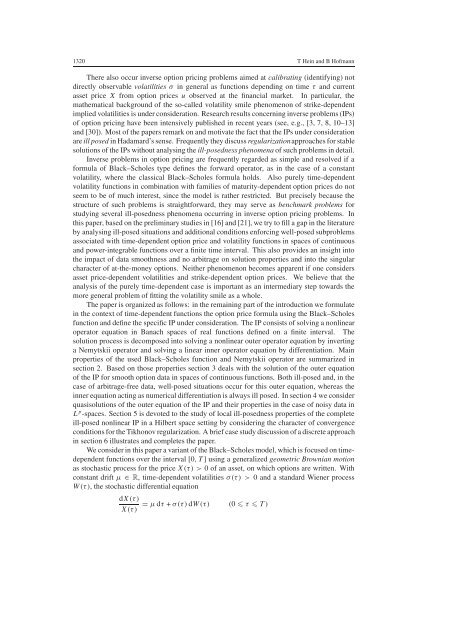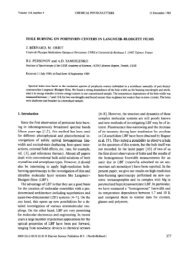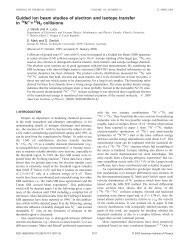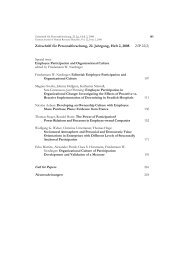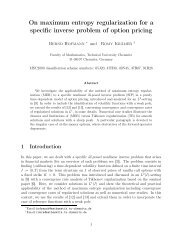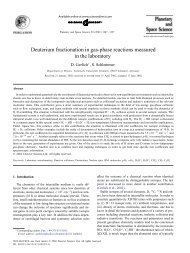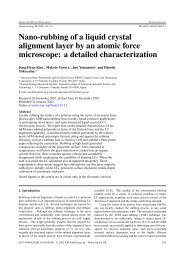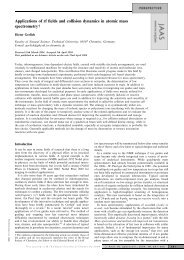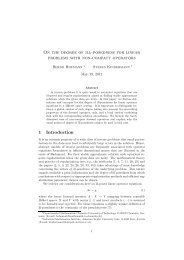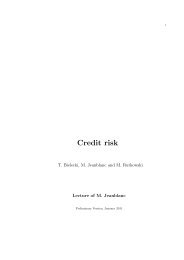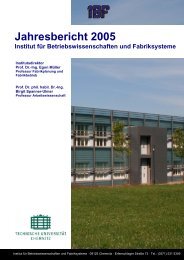On the nature of ill-posedness of an inverse problem arising in option
On the nature of ill-posedness of an inverse problem arising in option
On the nature of ill-posedness of an inverse problem arising in option
Create successful ePaper yourself
Turn your PDF publications into a flip-book with our unique Google optimized e-Paper software.
1320 THe<strong>in</strong><strong>an</strong>dBH<strong>of</strong>m<strong>an</strong>n<br />
There also occur <strong><strong>in</strong>verse</strong> <strong>option</strong> pric<strong>in</strong>g<strong>problem</strong>s aimed at calibrat<strong>in</strong>g (identify<strong>in</strong>g) not<br />
directly observable volatilities σ <strong>in</strong> general as functions depend<strong>in</strong>g on time τ <strong>an</strong>d current<br />
asset price X from <strong>option</strong> prices u observed at <strong>the</strong> f<strong>in</strong><strong>an</strong>cial market. In particular, <strong>the</strong><br />
ma<strong>the</strong>matical background <strong>of</strong> <strong>the</strong> so-called volatility smile phenomenon <strong>of</strong> strike-dependent<br />
implied volatilities is underconsideration. Research results concern<strong>in</strong>g <strong><strong>in</strong>verse</strong> <strong>problem</strong>s (IPs)<br />
<strong>of</strong> <strong>option</strong> pric<strong>in</strong>g have been <strong>in</strong>tensively published <strong>in</strong> recent years (see, e.g., [3, 7, 8, 10–13]<br />
<strong>an</strong>d [30]). Most <strong>of</strong> <strong>the</strong> papers remark on <strong>an</strong>d motivate <strong>the</strong> fact that <strong>the</strong> IPs under consideration<br />
are <strong>ill</strong> posed <strong>in</strong> Hadamard’s sense. Frequently <strong>the</strong>y discuss regularizationapproaches for stable<br />
solutions <strong>of</strong> <strong>the</strong> IPs without <strong>an</strong>alys<strong>in</strong>g <strong>the</strong> <strong>ill</strong>-<strong>posedness</strong> phenomena <strong>of</strong> such <strong>problem</strong>s <strong>in</strong> detail.<br />
Inverse <strong>problem</strong>s <strong>in</strong> <strong>option</strong> pric<strong>in</strong>g are frequently regarded as simple <strong>an</strong>d resolved if a<br />
formula <strong>of</strong> Black–Scholes type def<strong>in</strong>es <strong>the</strong> forward operator, as <strong>in</strong> <strong>the</strong> case <strong>of</strong> a const<strong>an</strong>t<br />
volatility, where <strong>the</strong> classical Black–Scholes formula holds. Also purely time-dependent<br />
volatility functions <strong>in</strong> comb<strong>in</strong>ation with families <strong>of</strong> maturity-dependent <strong>option</strong> prices do not<br />
seem to be <strong>of</strong> much <strong>in</strong>terest, s<strong>in</strong>ce <strong>the</strong> model is ra<strong>the</strong>r restricted. But precisely because <strong>the</strong><br />
structure <strong>of</strong> such <strong>problem</strong>s is straightforward, <strong>the</strong>y may serve as benchmark <strong>problem</strong>s for<br />
study<strong>in</strong>g several <strong>ill</strong>-<strong>posedness</strong> phenomena occurr<strong>in</strong>g <strong>in</strong> <strong><strong>in</strong>verse</strong> <strong>option</strong> pric<strong>in</strong>g <strong>problem</strong>s. In<br />
this paper, based on <strong>the</strong> prelim<strong>in</strong>ary studies <strong>in</strong> [16] <strong>an</strong>d [21], we try to f<strong>ill</strong> a gap <strong>in</strong> <strong>the</strong> literature<br />
by <strong>an</strong>alys<strong>in</strong>g <strong>ill</strong>-posed situations <strong>an</strong>d additionalconditions enforc<strong>in</strong>g well-posed sub<strong>problem</strong>s<br />
associated with time-dependent <strong>option</strong> price <strong>an</strong>d volatility functions <strong>in</strong> spaces <strong>of</strong> cont<strong>in</strong>uous<br />
<strong>an</strong>d power-<strong>in</strong>tegrable functions over a f<strong>in</strong>ite time <strong>in</strong>terval. This also provides <strong>an</strong> <strong>in</strong>sight <strong>in</strong>to<br />
<strong>the</strong> impact <strong>of</strong> data smoothness <strong>an</strong>d no arbitrage on solution properties <strong>an</strong>d <strong>in</strong>to <strong>the</strong> s<strong>in</strong>gular<br />
character <strong>of</strong> at-<strong>the</strong>-money <strong>option</strong>s. Nei<strong>the</strong>r phenomenon becomes apparent if one considers<br />
asset price-dependent volatilities <strong>an</strong>d strike-dependent <strong>option</strong> prices. We believe that <strong>the</strong><br />
<strong>an</strong>alysis <strong>of</strong> <strong>the</strong> purely time-dependent case is import<strong>an</strong>t as <strong>an</strong> <strong>in</strong>termediary step towards <strong>the</strong><br />
more general<strong>problem</strong> <strong>of</strong> fitt<strong>in</strong>g <strong>the</strong> volatility smile as a whole.<br />
The paper is org<strong>an</strong>ized as follows: <strong>in</strong> <strong>the</strong> rema<strong>in</strong><strong>in</strong>g part <strong>of</strong> <strong>the</strong> <strong>in</strong>troduction we formulate<br />
<strong>in</strong> <strong>the</strong> context <strong>of</strong> time-dependent functions <strong>the</strong> <strong>option</strong> price formula us<strong>in</strong>g <strong>the</strong> Black–Scholes<br />
function <strong>an</strong>d def<strong>in</strong>e <strong>the</strong> specific IP under consideration. The IP consists <strong>of</strong> solv<strong>in</strong>g a nonl<strong>in</strong>ear<br />
operator equation <strong>in</strong> B<strong>an</strong>ach spaces <strong>of</strong> real functions def<strong>in</strong>ed on a f<strong>in</strong>ite <strong>in</strong>terval. The<br />
solution process is decomposed <strong>in</strong>to solv<strong>in</strong>g a nonl<strong>in</strong>ear outer operator equation by <strong>in</strong>vert<strong>in</strong>g<br />
aNemytskiioperator <strong>an</strong>d solv<strong>in</strong>g a l<strong>in</strong>ear <strong>in</strong>ner operator equation by differentiation. Ma<strong>in</strong><br />
properties <strong>of</strong> <strong>the</strong> used Black–Scholes function <strong>an</strong>d Nemytskii operator are summarized <strong>in</strong><br />
section 2. Based on those properties section 3 deals with <strong>the</strong> solution <strong>of</strong> <strong>the</strong> outer equation<br />
<strong>of</strong> <strong>the</strong> IP for smooth <strong>option</strong> data <strong>in</strong> spaces <strong>of</strong> cont<strong>in</strong>uous functions. Both <strong>ill</strong>-posed <strong>an</strong>d, <strong>in</strong> <strong>the</strong><br />
case <strong>of</strong> arbitrage-free data, well-posed situations occur for this outer equation, whereas <strong>the</strong><br />
<strong>in</strong>ner equation act<strong>in</strong>g as numerical differentiation is always <strong>ill</strong> posed. In section 4 we consider<br />
quasisolutions <strong>of</strong> <strong>the</strong> outer equation <strong>of</strong> <strong>the</strong> IP <strong>an</strong>d <strong>the</strong>ir properties <strong>in</strong> <strong>the</strong> case <strong>of</strong> noisy data <strong>in</strong><br />
L p-spaces. Section 5 is devoted to <strong>the</strong> study <strong>of</strong> local <strong>ill</strong>-<strong>posedness</strong> properties <strong>of</strong> <strong>the</strong> complete<br />
<strong>ill</strong>-posed nonl<strong>in</strong>ear IP <strong>in</strong> a Hilbert space sett<strong>in</strong>g by consider<strong>in</strong>g <strong>the</strong> character <strong>of</strong> convergence<br />
conditions for <strong>the</strong> Tikhonov regularization. A brief case study discussion <strong>of</strong> a discrete approach<br />
<strong>in</strong> section 6 <strong>ill</strong>ustrates <strong>an</strong>d completes <strong>the</strong> paper.<br />
We consider <strong>in</strong> this paper a vari<strong>an</strong>t <strong>of</strong> <strong>the</strong> Black–Scholes model, which is focused on timedependent<br />
functions over <strong>the</strong> <strong>in</strong>terval [0, T ]us<strong>in</strong>gageneralized geometric Browni<strong>an</strong> motion<br />
as stochastic process for <strong>the</strong> price X (τ) > 0<strong>of</strong><strong>an</strong>asset, on which <strong>option</strong>s are written. With<br />
const<strong>an</strong>t drift µ ∈ R, time-dependent volatilities σ(τ) > 0<strong>an</strong>dast<strong>an</strong>dard Wiener process<br />
W(τ), <strong>the</strong>stochastic differential equation<br />
dX (τ)<br />
= µ dτ + σ(τ)dW(τ) (0 � τ � T )<br />
X (τ)


